

Running a business or a project can be a full-blown adventure. While it’s no scuba diving or paragliding, you often find yourself pressed to act fast in the face of new challenges and opportunities. So, what do you do—make a rash decision or take a calculated risk? 😅
Now, any project manager will tell you how costly the decisions based on poor risk estimations can get. You’re looking at botched operations, reduced profitability, compromised reputation, and even complete project failure.
Luckily, it’s easy to keep track of potential threats and opportunities for any venture through a well-established project risk identification process. That’s why many successful businesses incorporate detailed identification practices within their risk management exercise, regardless of their size, scale, or industry.
In this blog, we’ll learn about what the risk identification process entails for a project team, exploring:
- Basic concepts within the risk identification lifecycle
- Common mistakes while identifying risks
- Useful risk identification strategies and examples
Risk Identification and its Role in Risk Management
Most of us intuitively try to identify new risks both in business and everyday lives. For instance, paragliders evaluate factors like weather conditions and the state of safety gear to plan better and avert accidents. The term risk identification simply aims to formalize this process in project management.
Risk identification enables project managers to plan for all potential uncertainties and Black Swan events that can impact a business negatively. The impact can be in terms of operational feasibility, profitability, and reputation, so the exercise covers pinpointing the risks involved from all those perspectives.
Risk identification is a standard process that initiates a business or project’s risk management. Here are the four stages within a regular risk management plan:
- Identify potential risks
- Carry out quantitative or qualitative risk assessment for identified risks
- Treat the risk based on severity—accept, mitigate, transfer, or avoid
- Monitor and report on treatment strategies
What is the standard risk identification lifecycle like?
According to the Project Management Institute, the risk identification lifecycle should include the following steps:
- Specifying a Template or a Risk Statement to define what covers a “risk”
- Basic identification of risks according to the template
- Detailed identification of each risk in terms of expected damage
- Validating risks against the project’s scope and external factors
- Final presentation of the overall risk through flowcharts, matrices, or other diagrams
Based on the final findings, risk management strategies like contingency planning and hedging are implemented to minimize the impact of important risks.
While it’s up to a project manager to determine what their risk statement or identification exercise should look like, there are several risk assessment templates available that can expedite the process.
For instance, the ClickUp Risk Analysis Whiteboard Template can offer much-needed visibility to your entire risk identification lifecycle. It comes with a customizable color-coded map where you and your project team can identify potential risks and document their probability and magnitude, all in one place.
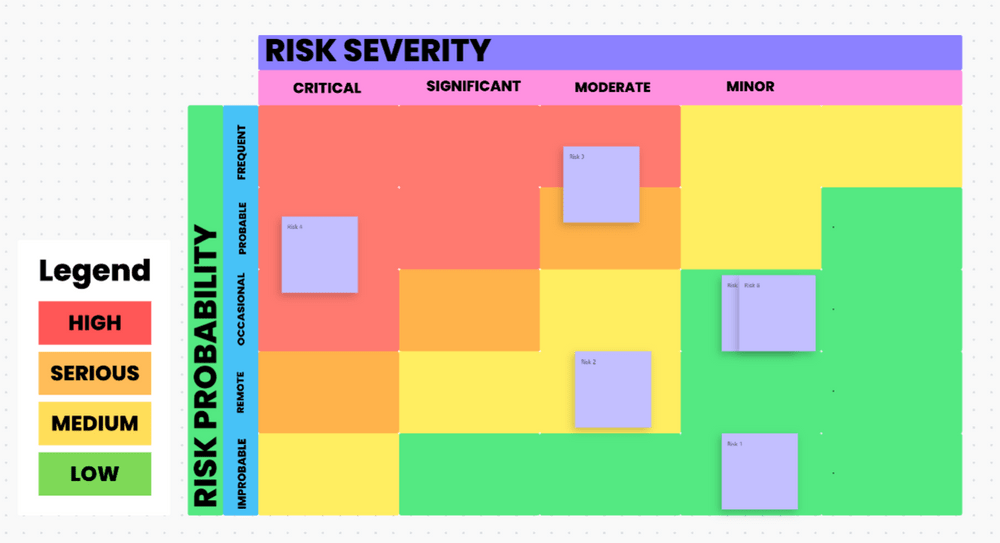
Keep in mind that your risk statement should be super inclusive, ideally offering a 360॰ view of both internal and external factors influencing the business, such as:
- Internal operations, workflows, and processes
- Market trends
- Disruptive innovations by competitors
- Cybersecurity risks
Most identified risks are negative risks, i.e., risks (like resource shortages) that can harm your business. However, some project managers also use the term positive risks to pinpoint opportunities, i.e., risks (like the early delivery of a project) you can exploit for your benefit.
Why Is Project Risk Identification Important? Key Advantages
Besides timely identification of business vulnerabilities, risk identification provides the following key advantages:
- Sharper decision-making: Action stems from information. Being aware of project risks gives you better leverage while making strategic decisions
- Prioritization of threats: Since project risk identification helps measure each risk event, it gets easier to prioritize potential threats in the order of likelihood or severity
- Improved cost management: Knowledge of risks involved in different project elements allows you to allocate resources and budgets strategically. For example, you don’t overcommit to risky initiatives, minimizing project cost risks and losses
- Compliance with legal requirements: In industries like finance and healthcare, risk identification is often a part of compliance with statutory requirements
9 Risk Identification Strategies for Business and Project Success
There are multiple strategies and techniques you can use to pinpoint risks throughout the project lifecycle. We’ll explore nine widely used and effective risk identification methods in the following sections.
Bonus: Identifying and managing risks is easier when you have reliable project management software to assist you. That’s why we’ll introduce some templates and functions within ClickUp, a top-rated project management tool, to help you implement risk detection strategies with extra precision.
1. Regular documentation reviews
Project risks often arise because of inconsistent or incomplete documentation that leaves your teams blocked down the line. The best practice here is to micro-scan your documents for mismatched references, incomplete process maps, unclear or outdated requirements, scheduling errors, and inaccurate estimates.
The documents you may want to inspect include:
- Project plan
- Product requirements document
- Project objectives, scope, and value statements
- Cost estimates
- Work breakdown structure (WBS)
You can now keep your project data and risk statements within a unified place—ClickUp Docs. Build a connected network of project documents, timelines, and SOPs. Link your resource items or create tags to ensure everything is easily accessible. You can even use ClickUp AI to generate project docs free from human errors.

The best part is that ClickUp Docs is collaboration-friendly. Use built-in Chat, Comments, Mention, and Proofing tools during your risk identification exercise to pinpoint inconsistencies to the project manager or the risk owner.
2. SWOT analysis
SWOT analysis is the go-to risk identification and mapping technique for businesses worldwide. It aims to list the Strengths, Weaknesses, Opportunities, and Threats in your venture.
The weaknesses and threats point out the negative risks that make your business vulnerable; opportunities denote the positive risks, while strengths include the capabilities your business can use to fight back risks and capitalize on opportunities.
You can easily conduct this exercise using the various SWOT analysis templates on ClickUp. They’re tailored to the needs of businesses, individual projects, and other use cases. Our best picks include:
- ClickUp Personal SWOT Analysis Template
- ClickUp Operations Management SWOT Analysis Template
- ClickUp SWOT Analysis Executive Summary Template
If you’re a visualization aficionado, you can use ClickUp Whiteboards to identify potential risks during your SWOT analysis process.
Whiteboards allow for real time collaboration between teams. Just get your risk management team on board, and they can use tools like sticky notes, connectors, highlighters, and shapes to discuss project components contextually. 🧐

3. Brainstorming
Another way to identify risk in any endeavor is by brainstorming with your team. It allows colleagues from different departments to come together, review the project from their niche perspective, and uncover previously unknown risks. 🧠
There are multiple brainstorming techniques that help identify potential risks. However, mind mapping best serves this purpose as it not only allows you to identify common risks but also visualize the relationships between them.
You can start creating a mind map with ClickUp in seconds. Just navigate to Mind Maps, get your team members to join in, and use the collective knowledge to map out continuous process flows. Add nodes for potential risk events and adjust the map with simple drag-and-drop moves.
The visual network helps you predict if one risk factor can snowball into major roadblocks. Once your brainstorming session is complete, save the mind map in your project Workspace and reuse it for further risk treatment analysis.

4. Stakeholder interviews
If you want to detect possible risks from multiple perspectives, it can pay off to take the input of key project stakeholders, such as your client, end users, operational employees, and product and asset managers. This helps you avoid decisions that may negatively impact a major stakeholder.
Ideally, you can detect a project risk through well-structured stakeholder interviews—prefer one-on-one sessions to get more direct answers. Alternatively, you can also use ClickUp Forms to reach out to them through detailed questionnaires specific to your product or project.
5. Expert judgment
Besides stakeholders, you can also consult domain experts for risk-related advice on your project. They typically have industry specialization and years of hands-on experience, which gives them the edge while analyzing any risk data. They can pick up on many potential risks that startups and new business owners tend to miss.
The best way to gather expert opinion on any project risk is by using the Delphi technique. It’s a method involving multiple rounds of questionnaires with a panel of experts—the end goal is to arrive at a consensus free from personal biases.
6. Root cause analysis
While most risk detection approaches connect a risk to an impact, root cause analysis does the opposite. Here, you first identify the impact (undesirable result) and then trace it back to the risk factors triggering it.
It’s all about intricate data visualization—say, the undesirable result is a delayed project. In this case, you’ll visualize your project schedule to uncover issues like an unaddressed dependency or a missed supply order that derailed the timing.
The ClickUp Root Cause Analysis Template is a must-have for exposing and troubleshooting risks within ongoing projects. It helps categorize issues as Whys until you arrive at the Winning Solution, all neatly stacked in Custom Fields.
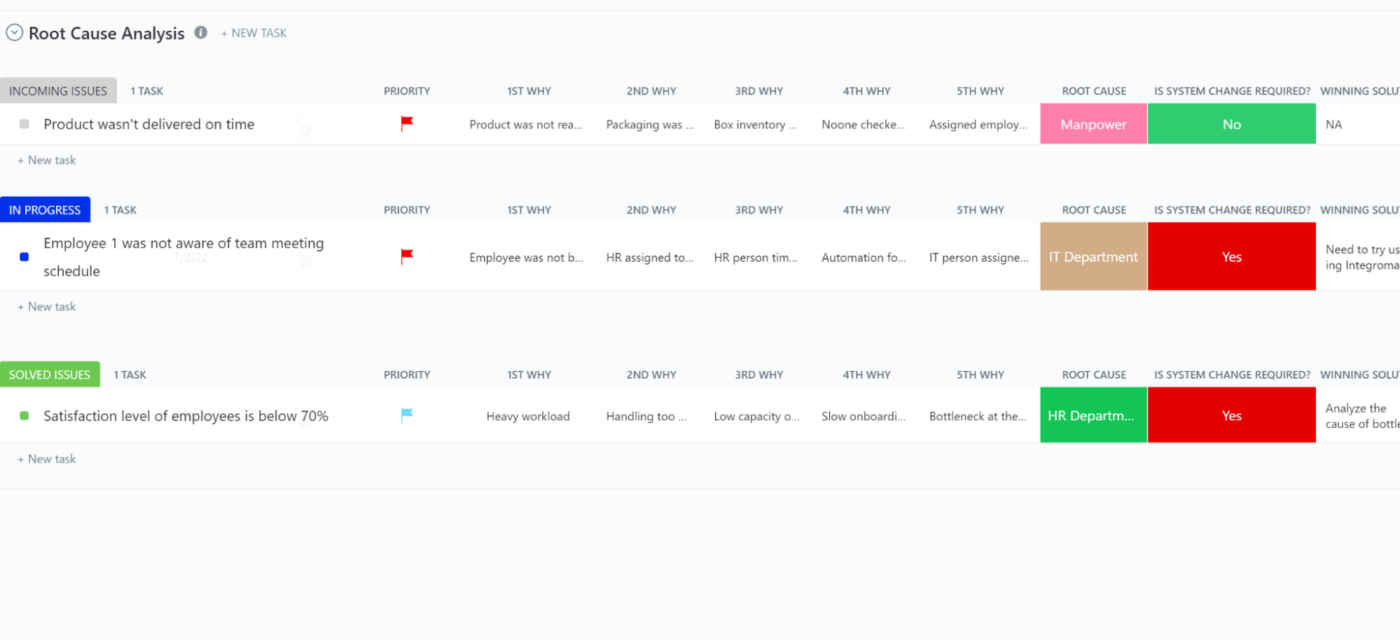
But if you’re still planning your project schedule, you’ll have a more proactive time pinpointing risks with ClickUp Dependencies and Gantt Charts. You can create dependencies for interconnected tasks in a few clicks and visualize all of them in the Gantt Chart view.
The result is a flexible timeline where it’s easy to keep tabs on process bottlenecks or external delivery hiccups. Do you need to accommodate a new risk? You can create new dependencies with a simple drag-and-drop action, and the rest of the schedule adjusts automatically.
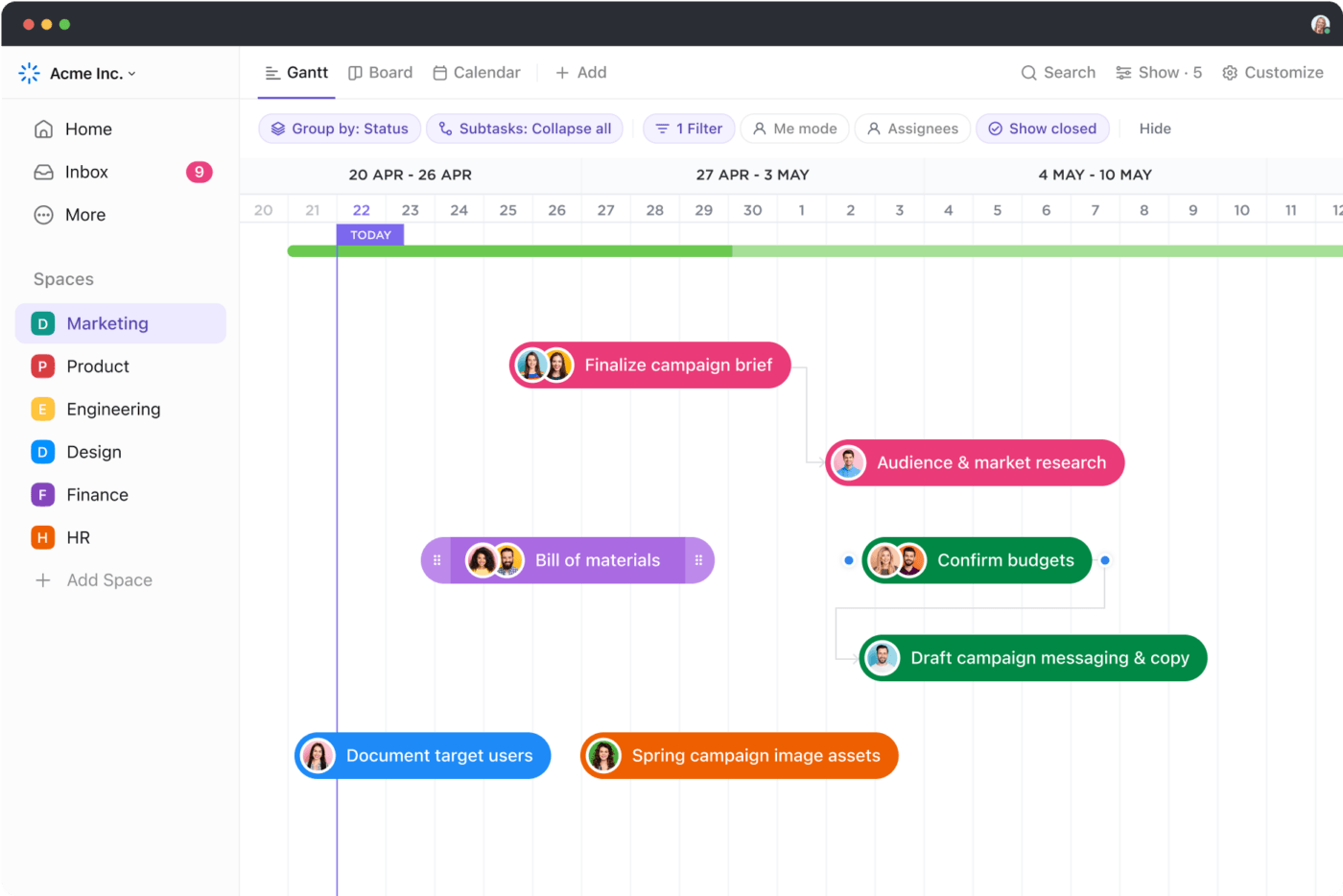
7. Assumption analysis
Each project is built on certain assumptions, which inherently add risk and uncertainty to the outcome. Common examples include the estimated project timeline, availability of team members, and delivery timing for raw materials. The likelihood of any of these assumptions going wrong is a risk. 🫠
Now, for assumption analysis, try to identify all the assumptions in your project plan and the extent of tolerable deviation. For example, you assume your raw material supplies will arrive on the 10th of each month. But without timely delivery, your reserve inventory would only last for three days. Your manufacturing process will be blocked if the supplies are delayed for more than three days, which calls for alternative arrangements.
The question is, how do you keep track of all the assumptions in your business?
Fortunately, with ClickUp Automations, you can effortlessly put a monitoring system in place for all your assumptions. Use it to set up fully automated workflows without any coding knowledge—just define a trigger event and the action to be taken.
For instance, to set up a workflow for monitoring assumptions related to team availability, you can:
- Define an unavailability count as the trigger event. Let’s say you set the trigger to when three of your team members are unavailable at the same time
- Specify the action, which, in this case, can be to flash a notification in your ClickUp Workspace—the alert will help you take timely action to prevent delays

8. Monte Carlo analysis
The Monte Carlo analysis is to quantify the possibility of a risk event through simulation. You need a computer-generated program built on a mathematical model—it runs various simulations based on input and output variables to predict the possibility of each risk.
The easiest way to conduct this analysis is through predictive analytics software or similar risk identification tools. Once you have your detected risks, you can import the data into ClickUp and visualize the reports on a customizable Dashboard through options like cards and graphs.
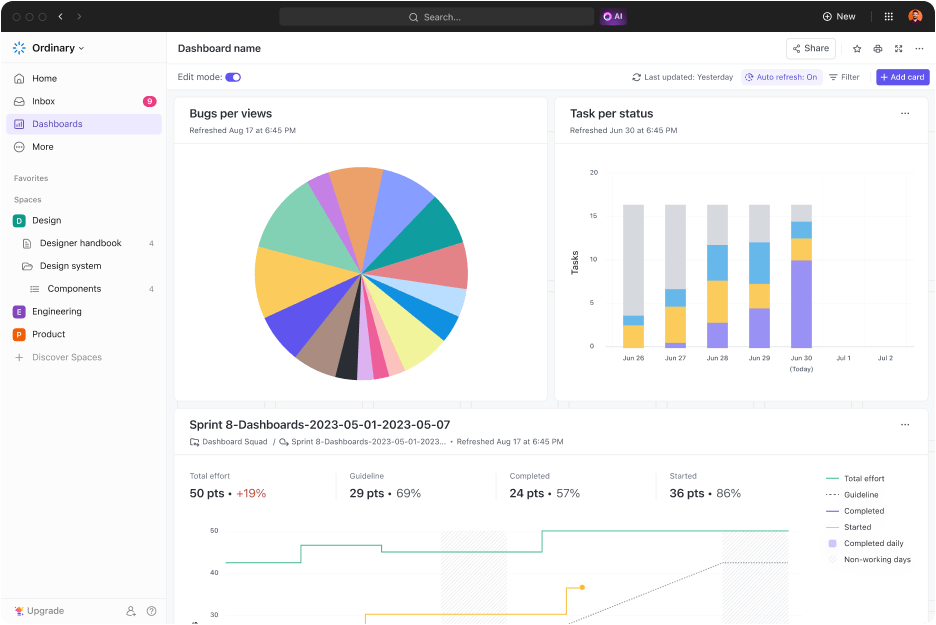
9. Identify risks with a risk register
A risk register is one of the best tools to organize risk data systematically. It allows you to record all potential risk events, their impact, likelihood, and other crucial information like risk owner, source, and rating. This information streamlines the risk mapping process and serves as a single source of truth for any future course of action.
ClickUp offers simple to sophisticated risk register templates to support all types of projects. If you need to document risks in an easy-to-understand format, the ClickUp Risk Register Template is your best bet.
If you need a more extensive template covering your entire risk management plan, you’ll love the ClickUp Project Management Risk Analysis Template. Its risk register section includes color-coded cells to record each risk’s impact, likelihood, and ratings and even designated columns to record the estimated financial impact.
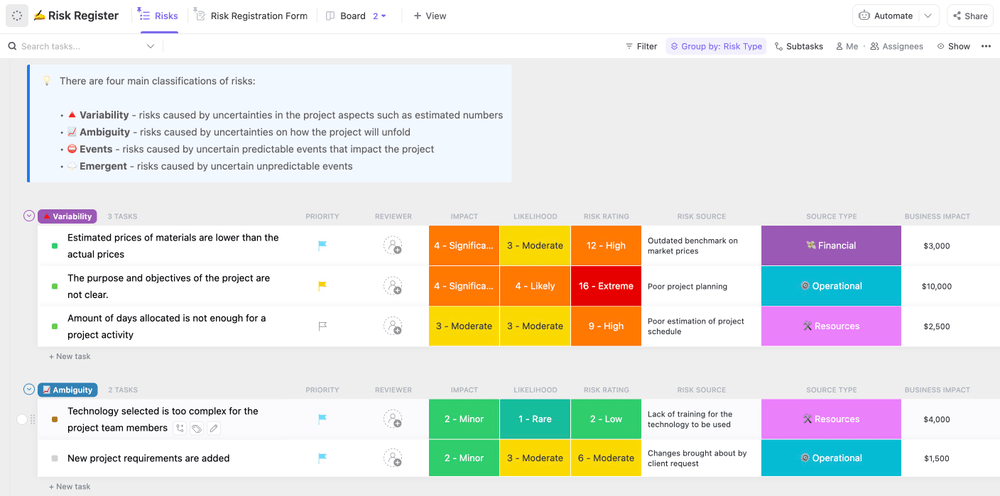
Examples of Risk Identification
Strengthen your knowledge by navigating three robust scenario-based examples of risk identification below.
1. App development example
A company specializing in business software development lands its first project to build a consumer-facing gaming app. This promising project can generate substantial revenue but is relatively riskier as it’s a new niche for the company.
Here, the project manager conducts a risk assessment exercise, say SWOT analysis, with team members and holds stakeholder interviews. After adequate evaluation, they identify the following primary risks:
- Vague estimation of the project timeline
- Unavailability of key employees at crucial points leads to unaddressed bugs and issues
- Scope creep (significant change in the project objective and delivery requirements)
- Ever-changing demands of end users
The project team prepares a risk register to outline solutions against individual risks as part of an effective risk management plan. For instance, the project manager:
- Finalizes a project scope and deadline
- Designs an agile workflow on ClickUp to accommodate team unavailability
- Starts using the ClickUp Bug & Issue Tracking Template with built-in Automations and custom intake Forms, allowing the project team to stay aligned with user needs
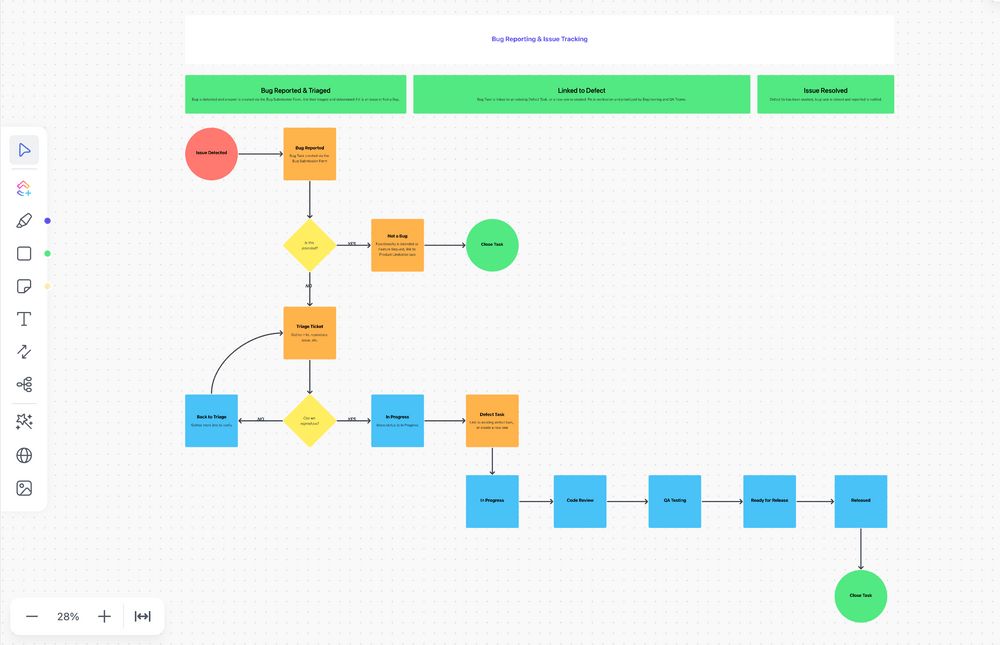
2. Product manufacturing process example
A consumer electronics manufacturer recently concluded one of its most profitable quarters. While the business is doing well, the company has also experienced some turbulence in its manufacturing operations, so its risk managers get to work.
The managers work with a team of management consultants to identify the following business risks that can hit the company’s bottom line:
- Delay in the supply of raw material
- Surge in the pricing of key components
- Depreciated machines increase the risk of accidents at the factory
- Potential intellectual property theft
The risk managers contact the operations manager to identify the actual risk sources. Managing potential risks here may entail:
- Negotiations with suppliers
- Machinery replacement
- Stronger on-site and cybersecurity measures
3. Construction project example
A company has won a contract to build a residential complex with 100+ apartments. Since it’s a large-scale construction project, managers use various risk identification methods to proactively identify all the risks before starting the on-site work. Potential risks include:
- Delay in regulatory clearance
- Budget overruns due to labor strike
- Contractor or subcontractor default
- Safety hazard due to a malfunctioning trencher
The project manager plans alternative directions to reduce risk levels for each item. The team can eliminate relevant risks on the go and stick to the budget as the project progresses, thanks to the refined and solution-centric alternative plan.
Common Issues while Identifying Risk and How to Overcome Them
For the risk identification process to serve its intended purpose, there are certain issues you need to keep an eye out for:
Reliance on outdated risks
Many projects fail because managers only rely on the overall risk assessed at the beginning of the initiative. In reality, risk parameters tend to shift with changing market and environment dynamics. According to global risk management standards like ISO 31000, you must revisit your identified risks regularly and adjust your treatment strategy accordingly.
Poor tracking of risk severity
The findings of risk identification are used to profile each risk in terms of its potential impact, and that’s where many project managers lose their way. They’re unable to accurately evaluate the gravity of a risk, leading to impaired judgment.
The solution here is to identify each risk factor with at least one detectable and measurable metric that can be used to quantify its severity. For example:
- For risks related to a disruptive technology, the measurable metric can be its market share or adoption rate
- For internal process risks that can affect output, the metric can be productivity levels tracked through project team timesheets
Human errors during the project risk identification process
Finally, human errors can be made while analyzing internal and external threats. Team members can miss a risk factor, record a metric inaccurately, and overestimate and underestimate risks, especially if they’re also busy with other tasks.
To avoid this issue, hire domain experts or assign a dedicated team to handle the risk identification process with greater care.
Bolster Your Risk Management Process with ClickUp
Risk identification is the foundation of any risk management process, and as you can see by now, it’s quite a complex exercise. It requires hours of careful planning and brainstorming and the right tools and templates to complete the process without errors.
Luckily, ClickUp brings the necessary tools and templates in one place so you identify risks and systematically treat them. From tracking resource shortages to visually mapping potential risks, it can back you up like no other tool.
Sign up to ClickUp for free and start your project risk identification exercises right away! 💗



